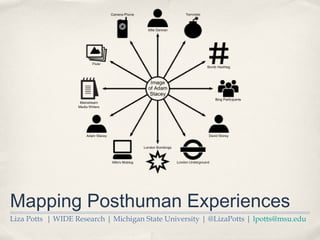
Mapping Experiences with Actor Network Theory
- 1. Mapping Posthuman Experiences Liza Potts | WIDE Research | Michigan State University | @LizaPotts | lpotts@msu.edu
- 2. mapping for experiences mapping systems help us understand uses, flow, states several types of mapping systems exist UML, basic flowcharting, activity theory diagrams, etc. we map before building apps, changing processes, etc. with a major focus on activities (verbs) often missing: actors (nouns) who/what participate in activities
- 3. UML Unified Modeling Language traditional diagramming to design products, services, & processes drives the approach of systems design, software design, and process improvement use cases, activity diagrams, state diagrams, etc.
- 4. use cases UML | action-oriented, verbs, single-participant / single-activity
- 5. activity diagram UML | activity-oriented, flow, single-participant / single-activity
- 6. sequence diagram UML | system-oriented, actions, two or more systems/ relaying activity
- 7. missing component: context how can we map for experience w/o knowing who/what is there? need to know who participates before we can build for participation what people are involved? what technologies are available? what organizations are involved? what locations are involved (physical or virtual)? what events are occurring to spur action? what other people, places, things are part of the network?
- 8. actor network theory actor-network theory (ANT) originated from Latour, Law, and Callon working in the field of STS, Latour shook up then-current theories in sociology by suggesting all participants (actors), whether they are human or nonhuman, have equal agency to affect any given situation actors come together to form temporary networks anchored by another actor, creating assemblages of relations specific to an individual act or broader event and forming a collective (an “actant”) an actant is a network comprising any actors—cell phones, blogs, people, etc—that have the ability to act and do act within the network
- 9. ANT mapping a method for understanding the context of workplace technologies, organizations, and people before documenting tasks, processes, and workflows a way for researchers to visualize their field-based research (whether offline or online) as assemblages of people, organizations, and technologies
- 10. why mapping provides a strong strategic view of the research spaces that technical communication scholars often explore diagramming the people, places, organizations, events, and technologies can empower design teams to know their audience’s context, relationships, and distribution before they attempt to create innovations diagrams can help teams reach common ground more quickly by collaboratively developing a shared understanding of the implications of their proposed product designs, policies, and services
- 11. when to map when you want to know who is participating when you are trying to understand context before building any products, services, processes examining actors and networks provides a broader understanding of the people, organizations, technologies, groups, places, and events important to mediated systems
- 12. how to map start on paper, whiteboard move on to some kind of digital tool for ease of sharing powerpoint / keynote omnigraffle / visio inkscape / illustrator find stencils Noun Project, clip art, etc. (basic = better)
- 13. what to map look for actors who are active in the networks you are analyzing document only nouns - not verbs (use UML for that) nouns such as... people: moderator, commenter, poster, anchor organizations: CDC, Red Cross, MSU, EFF technologies: iPhone, Google Doc, Nexus7 objects: tweet (noun, not verb), blog post, video comment
- 14. nouns human and non-human | people, places, things
- 15. patterns using stencils or similar placeholders to identify similar objects
- 16. relationships using stencils or similar placeholders to identify similar objects
- 17. thank you! Obligatory book plug: First book in our new ATTW series from Routledge Coming Late Summer 2013 http://attw.org/publications/boo lpotts@ msu.edu | @LizaPotts
- 18. references/recommendations Callon, M. (1986). Some elements of a sociology of translation: Domestication of the scallops and the fishermen of St. Brieuc Bay. In J. Law (Ed.), Power, action, & belief. A new sociology of knowledge? (pp. 196–229). London: Routledge. Latour, B. (1987). Science in action: How to follow scientists and engineers through society. Cambridge, MA: Harvard University Press. Latour, B. (1996). Aramis. Or the love of technology. (C. Porter, Trans.). Cambridge, MA: Harvard University Press. (Original work published 1993). Latour, B. (1999). Pandora’s hope: Essays on the reality of science studies. Cambridge, MA: Harvard University Press. Latour, B. (2005). Reassembling the social. New York: Oxford University Press. Law, J. (1992). Notes on the theory of the actor-network: Ordering, strategy and heterogeneity. Systems Practice, 5, 379–393. Mol, A., & Law, J. (1994). Regions, networks and fluids: Anaemia and social topology. Social Studies of Science, 24, 641–671. With thanks & attribution to the awesome artists of my icons:The Noun Project: http://thenounproject.com/using-symbols/ Bird designed by Thomas Le Bas from The Noun Project. Bomb designed by Adam M. Mullin from The Noun Project. Building designed by Nate Eul from The Noun Project. Calendar designed by Marcio Duarte from The Noun Project. Camera Phone designed by Roy Milton from The Noun Project. Circle designed by Thomas Le Bas from The Noun Project. Coastal designed by Iconathon from The Noun Project. Community designed by T. Weber from The Noun Project. Desk designed by James Thoburn from The Noun Project. Explosion designed by Renee Ramsey-Passmore from The Noun Project. Fax Machine designed by Braden Stranks from The Noun Project. Gears designed by Dima Yagnyuk from The Noun Project. Hash designed by P.J. Onori from The Noun Project. Hurricane designed by The Noun Project. India designed by Satheesh CK from The Noun Project. Information Technology designed by United Nations OCHA from The Noun Project. London Underground designed by Viktor Hertz from The Noun Project. Network designed by The Noun Project. Notebook designed by Brendan Lynch from The Noun Project. Picture designed by mooooyai from The Noun Project. United States designed by James Keuning from The Noun Project. User designed by Denis Chenu from The Noun Project.
